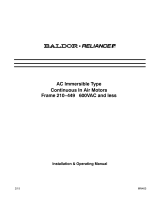
English (US)
18
9.2 Startup
1. Gradually open the isolating valve in the suction line until a
steady stream of airless water runs out of the priming hole.
2. Close the plug and tighten securely.
3. Completely open the isolating valves.
For pumps with Cool-Top
®
, see section 16. Startup of pump with
air-cooled top (Cool-Top
®
).
Follow these steps:
1. Switch off the power supply.
2. Check to make sure the pump has been filled and vented.
3. Remove the coupling guard and rotate the pump shaft by
hand to make sure it turns freely.
4. Verify that the electrical connections are in accordance with
the wiring diagram on the motor.
5. Switch on the power and observe the direction of rotation.
When viewed from above, the pump should rotate counter-
clockwise (clockwise for CRN-SF).
6. To reverse the direction of rotation, first switch off the power
supply.
7. On three-phase motors, interchange any two phases of the
power supply.
On single-phase motors, see wiring diagram on the
nameplate. Change wiring as required.
8. Switch on the power again and check for proper direction of
rotation. Once direction of rotation has been verified, switch
off the power again. Do not attempt to reinstall the coupling
guards while the motor is on. Replace the coupling guard if
the direction of rotation is correct. When the guards are in
place, the power can be switched on again.
10. Operation
10.1 Operating parameters
CR multi-stage centrifugal pumps installed in accordance with
these instructions and sized for correct performance will operate
efficiently and provide years of service. The pumps are water-
lubricated and do not require any external lubrication or
inspection. The motors may require periodic lubrication as
described in section 12. Maintaining the motor.
Under no circumstances should the pump be operated for any
prolonged periods of time without flow through the pump.
This can result in motor and pump damage due to overheating.
A properly sized relief valve should be installed to allow sufficient
liquid to circulate through the pump to provide adequate cooling
and lubrication of the pump bearings and seals.
10.2 Pump cycling
Pump cycling should be checked to ensure the pump is not
starting more often than the following max. starts per hour:
Grundfos ML motors:
• 200 times per hour on 1/3 to 5 hp models
• 100 times per hour on 7 1/2 to 15 hp models
• 40 times per hour on 20 to 30 hp models.
Baldor motors:
• 20 times per hour on 1/3 to 5 hp models
• 15 times per hour on 7 1/2 to 15 hp models
• 10 times per hour on 20 to 100 hp models.
Rapid cycling is a major cause of premature motor failure due to
overheating of the motor. If necessary, adjust controller to reduce
the frequency of starts and stops.
10.3 Boiler feed installations
If the pump is used as a boiler feed pump, make sure the pump is
capable of supplying sufficient water throughout its entire
evaporation and pressure ranges. Where modulating control
valves are used, a bypass around the pump must be installed to
ensure pump lubrication. See section 7.3 Minimum inlet
pressures.
10.4 Frost protection
If the pump is installed in an area where frost could occur, the
pump and system should be drained during freezing
temperatures to avoid damage. To drain the pump, close the
isolating valves, remove the priming plug and drain plug at the
base of the pump. Do not refit the plugs until the pump is to be
used again. Always replace the drain plug with the original or an
exact replacement. Do not replace with a standard plug.
Internal recirculation will occur, reducing the output pressure and
flow.
11. Maintaining the pump
Depending on the conditions and operating time, make the
following checks at regular intervals:
• Check that the pump meets the required performance and is
operating smoothly and quietly.
• Check that there are no leaks, particularly at the shaft seal.
• Check that the motor is not overheating.
• Remove and clean all strainers or filters in the system.
• Check that the tripping function of the motor overload
protection works.
• Check the operation of all controls.
• If the pump is not operated for unusually long periods,
maintain the pump in accordance with these instructions.
In addition, if the pump is not drained, the pump shaft should
be manually rotated or run for short periods of time at monthly
intervals.
• In severe-duty applications, pump life may be extended by
performing one of the following actions:
– Drain the pump after each use.
– Flush the pump with water or other liquid that is compatible
with the pump materials and process liquid.
– Disassemble the pump and thoroughly rinse or wash
components in contact with the pumped liquid with water or
other liquid that is compatible with the pump materials and
process liquid.
If the pump fails to operate or there is a loss of performance, see
to section 17. Diagnosing specific problems.
For CR, CRI, CRN 1s to 5 it is advisable to open
the bypass valve during start-up. See fig. 13.
The bypass valve connects the suction and
discharge sides of the pump, thus making the
filling procedure easier. Close the bypass valve
when operation is stable.
Motors should not be run unloaded or uncoupled
from the pump at any time; damage to the motor
bearings will occur.
Do not start the pump before priming or venting
the pump. See fig. 15. Never let the pump run dry.























